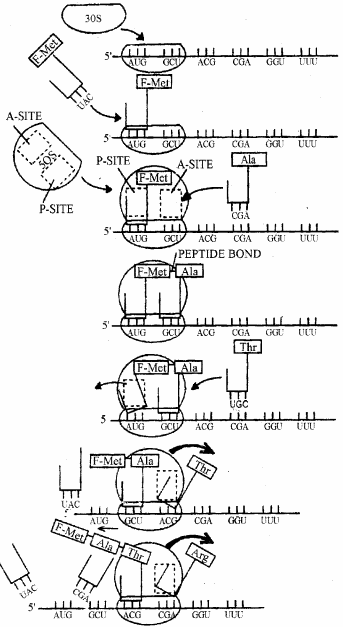Rajasthan Board RBSE Class 11 Biology Chapter 12 Molecular Biology
RBSE Class 11 Biology Chapter 12 Multiple Choice Objective Questions
Question 1.
Scientists who propounded double helical model of DNA-
(a) Khorana & Nirenberg
(b) Watson & Crick
(c) Beedle & Tautum
(d) Morgan & Bridges
Question 2.
Single standard DNA is found in-
(a) Bacteria
(b) TMV
(c) Φ X 174 bacteriophage
(d) Salmonella
Question 3.
The process that forms complementary RNA from DNA-
(a) Transcription
(b) Translation
(c) Transduction
(d) Terminalization
Question 4.
Codon is
(a) Sequence of two nucleotides in mRNA
(b) Sequence of three nucleotides in rRNA
(c) Sequence of three nucleotides in mRNA
(d) Sequence of two nucleotides in tRNA
Question 5.
Cistron is a…………….. unit of gene.
(a) Functional
(b) Recombination
(c) Complementary
(d) Mutation
Question 6.
Function of RNA polymerase is –
(a) Syntehsis of rRNA
(b) Synthesis of Hn-RNA
(c) Synthesis of tRNA
(d) All the above
Answer:
(1) b, (2) c, (3) a,(4) c, (5) a, (6)d.
RBSE Class 11 Biology Chapter 12 Very Short Answer Questions
Question 1.
Where DNA is found in organisms ?
Answer:
Nucleus.
Question 2.
Write the names of purine nitrogen bases.
Answer:
Adenine & Guanine.
Question 3.
Name any two types of DNA.
Answer:
A-DNA & Z-DNA.
Question 4.
Which nitrogen base is found in RNA in place of thymine.
Answer:
Uracil.
Question 5.
What is recon ?
Answer:
Unit of recombinations in gene.
Question 6.
What is triplet codon ?
Answer:
A sequence of three nucleotides that code one amino acid.
Question 7.
Where RNA polymerase is found in eukaryotic cell ?
Answer:
Nucleoplasm (nucleus).
Question 8.
Which is the initiation codon in protein synthesis.
Answer:
AUG.
RBSE Class 11 Biology Chapter 12 Short Answer Questions
Question 1.
Write the chemical composition of DNA.
Answer:
DNA is made up of three types of compounds viz. –
(A) Phosphoric acid
(B) Pentose sugar
(C) Nitrogen bases
(A) Phosphoric acid (H3po4)
It occupies the peripheral region of the DNA molecule. It is attached to the 5th carbon of sugar molecule of its own nucleotide in the form of phosphate group. It get attached to the 3rd carbon of the sugar of adjacent nucleotide. It is called as phosphodiester bond.
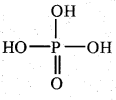
(B) Pentose Sugar:
It is deoxyribose type in DNA. Which has one oxygen atom less at carbon number 2. The first and fourth carbon atoms unite with a oxygen to form a ring.
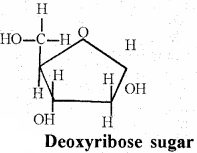
(C) Nitrogen base:
They are of two types-
(a) Purines – They are double ring (one hexa & one penta) compounds. They are of two types viz. – Adenine (A) and Guanine (G).
(b) Pyrimidines – They have one hexa ring. They are of two types in DNA viz. – Cytosine (C) and Thymine (T)
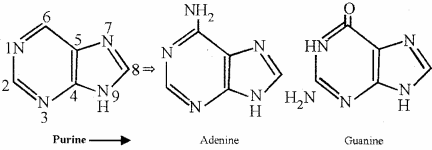
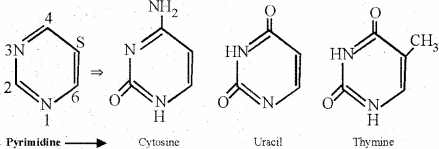
One molecule of nitrogen base (A or T or C or G) and one molecule of deoxyribose pentose sugar (dS) unite to form a nucleoside which is a subunit of DNA. The nucleosides are of 4 types viz. –
- dS + A – deoxyadenosine
- dS + G – deoxyguanosine
- dS + C – deoxycytidine
- dS + T – deoxythymidine
One molecule of phosphoric acid (P), one molecule of deoxyribose pentose sugar and one molecule of nitrogen base (A or G or C o T) unite to form nucteotide which is a structural unit of DNA. The nucleotides are of four types viz. –
- P + dS + A – Adenylic acid or AMP
- P + dS + G – Guanylic acid or GMP
- P + dS + C – Cytidylic acid or CMP
- P + dS + T – Thymidyli acid or TMP
The nucleotides unite to each other with the help of phosphodiester bonds to form polynucleotide chain. The phosphodiester bonds form the backbone of DNA molecule.
Question 2.
Give an account of Z- DNA.
Answer:
| Geometry attribute | A-DNA | B-DNA | C-DNA | D-DNA | Z-DNA |
|
Helix sense |
Right handed | Right handed | Right handed | Right handed | Left handed |
|
Helix length |
28A° | 34A° | 31A° | 24.24A° | 45.6A° |
|
Mean base pair per turn |
11 pairs | 10 pairs | 9.3 pairs | 8 pairs | 12 pairs |
| Rise per base pair along axis |
2.56A° | 3.4A° | 3.32A° | 3.03A° | 3.75A° |
| Diameter | 23A° | 20A° | 19A° | 19A° | 18A° |
| Inclination of base pair to axis |
19° | 6 ° | 7.8° | 16.7° | 9° |
Question 3.
Define gene.
Answer:
The gene is a smallest unit of genetics. The term gene was coined by Johanson (1909). The gene is a linear sequence of nucleotides in DNA that determines the heredity of a specific character. The genes store and express the genetic informations that will contribute towards the phenotype, and will be passed on to the successive generations. Each gene occupies a special position in a chromosome which is termed as locus.
Structure of Gene:
Seymor Benzer (1955) subdivided gene into different units such as-
- Cistron – It is the largest part of gene (DNA). It is the functional unit of gene. It can synthesize one polypeptide.
- Recon – It is the small part of the gene which is a unit of recombination. It may be as small as a single nucleotide pair. It can undergo crossing over & recommbination.
- Muton – It is smallest unit of the gene that can undergo mutation.
- Operon – It is a group of genes having an operator gene, a structural gene and other genes in sequence which all function as a unit.
- Replicon – It is the smallest part of DNA that replicates from a single origin of replication or any genetic element that can regulate and effect its own replication from initiation to completion.
- Complan – It is a DNA segment that is responsible for complementation. Some enzymes are made up of two or more polypetide chains. Their active groups are complementary to each other.
Question 4.
What are complementary genes. .
Answer:
One of two or more genes that when present together produce effects qualitatively different from the separate effect of any one of them.
Question 5.
Define genetic codon.
Answer:
Messenger RNA encodes a genetic message for protein synthesis which is decided by the DNA, as mRNA is transcribed by the DNA. The genetic message in mRNA is in the form of a sequence of nucleotides (bases). A specific sequence of nucleotides in mRNA specify one amino acid which is called as codon. The base sequence in tRNA that combines with codon is called as anticodon. The sequence of the nucleotides (bases) in mRNA that code 20 amino acids is called as genetic code. There are four types of nucleotides (bases) in mRNA and their arrangement code 20 amino acids.
Initially, singlet codon concept was considered which means one base (mucleotide) codes one amino acid. It gives only 4 genetic codes [4 x 1⇒ 4] which are very less to code 20 amino acids, hence discarded. Lateron, doublet codon concept was considered in which two nucleotides code one amino acid. This gives 16 genetic codes [4 x 4 ⇒16] which are not sufficient to code 20 amino acids, hence discarded.
Triplet Genetic Code:
Crick, Brenner et al. first demostrated that codons consist of three bases. Marshall Nirenberg and Heinrich J. Mathaei (1961) where the first to reveal the nature of a codon. According to triplet codon concept, three nucleotides (base) code one amino acid. It gives 64 genetic codes [4 x 4 x 4 = 64] which are more than enough to code 20 amino acids.
Holley, Khorana & Nirenberg studied all the 64 genetic codes, for this work they were awarded Nobel prize of 1968 in medicine/physiology. Nirenberg worked with Leder & determined 54 codons but Leder was not given the Noble prize.
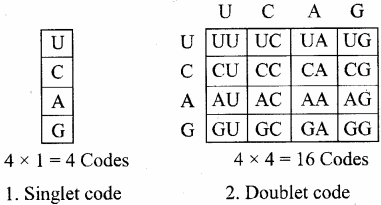
Question 6.
What is unidirectional flow of information.
Answer:
It was propounded by Crick (1958) and also called as central dogma. The flow of information from DNA to mRNA is called as unidirectional flow of information.
Question 7.
Give an account of polymerases found in eukaryotes.
Answer:
RNA polymerase catalyses the synthesis of different types of RNA from the DNA.
(a) Prokaryotes contain only one type of RNA polymerase. Each molecule of this RNA polymerase has a core part containing 4 polypeptide chains (2a chains, one P chain & one pi chain) and a attached s(sigma) chain or a factor. The a factor is attached loosely to the core enzyme.
(b) In eukaryotes, the nucleus has three types of RNA polymerases (R. Roeder and W.Rutter, 1969) viz.-
- Polymerase – I : It synthesizes three large rRNA (28S, 18S & 5.8S rRNA).
- Polymerase – II : It synthesizes hn RNA (mRNA precursor).
- Polymerase – III : It synthesizes small RNA (tRNA, 5S rRNA, S∩RNA).
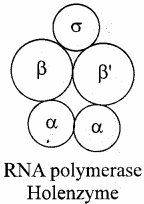
![]()
Question 8.
What do you mean by activation of amino acid ?
Answer:
Activation of Amino acids:
In the cytoplasm, the amino acids occur in inactive form, hence they cannot take part in protein synthesis. The activation of amino acids is done by ATP which results in the formation of aminoacyl adenylate. This process is catalyses by specific enzymes & there is a specific enzyme for a specific amino acid. The enzyme recognises its own amino acid & finds out its own tRNA.
![]()
RBSE Class 11 Biology Chapter 12 Essay Type Questions
Question 1.
Explain that DNA is a hereditary material.
Answer:
Scientists dealing in molecular biology proved with the help of experiments that DNA is a hereditory material. There are two main evidences viz –
(A) Griffith’s experiment:
It was done in 1928 by Frederick Griffith. It was one of the experiment showing that bacteria can get DNA through a process called transformation. He used two strains of bacteria, called Diplococcus pheumonae viz. – type II-R (rough or non virulent) and type III – S (Smooth or virulent). These bacteria infect rats & human beings.
The strain III- S is pathogenic and the strain II – R is non- pathogenic. The strain III- S covers itself with a polysaccharide capsule that protects it form the host immune system. This means that the host cell will die. The strain II-R does not have the protective capsule and it is killed by the host immune system.
In this experiment, the bacteria of strain III – S were killed by heat and their remains were added to strain II-R bacteria. The killed strain III-S and strain II-R harmed the mice but the blend of the two was able to kill mice. Griffith was also able to get both live II-R and III- S strains from the blood of these dead mice. He concluded that the type II-R had been transformed into the lethal III- S strain by transforming principle. Griffith observed-
- Strain III- S, when injected kill the mice.
- Strain II- R, when injected, the mice remained live (unaffected).
- Killed strain III- S when injected, the mice remained live (unaffected).
- When both the killed strain S – III and strain II – R were injected, they killed the mice.
Griffith concluded that while the bacteria of strain III-R had been killed, the DNA had survived the heating process and was taken up by the strain II-R. Armed with DNA of strain III-S, the bacteria of strain II-R developed the capsule and get protected from the host’s immune system and could kill the mice.
Hence, it can be concluded that DNA is the hereditory material.
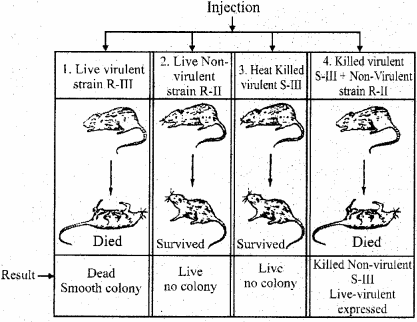
Lateron, the experiments done by Avery, McLeod and McCarty (1944) further proved that DNA is a hereditory materila.
They found that trypsin, chymotrypsin and ribonuclease (ezymes that break proteins & RNA) did not affect it, but an enzyme DNAase destroyed the transformation power.
This proves that, it was DNA rather than RNA, protein or other cell components that was responsible for transformation.
(B) Hershey-Chase Experiments:
A. Hershey and M.Chase conducted a series of experiments in 1952 that helped to confirm that DNA is genetic material.
Hershey and chase showed that when bacteriophages which were composed of DNA and protein, infect bacteria, their DNA enters the host bacterial cell not the other components.
They used radioactive phosphorus (P32) and sulphur (S35) in their experiments separately. Some of the bacteriophages were cultured in medium having P32 and some were cultured in medium having S35. They found that P32 labelled DNA and S35labeled proteins, i.e. in the bacteriophages DNA was labelled with P32, the proteins were normal and in which proteins were labeled with S35, the DNA was normal.
Above labeled bacteriophages were allowed to infect bacteria. The bacteria and bacteriophages were isolated by centrifugation. They found that only those bacteria which were infected with P32containing DNA showed radioactivity i.e. only DNA is tranformed at the time of infection.
Question 2.
Describe Watson & Crick model of DNA.
Answer:
structur of DNA:
DNA is found in all the plants, animals, prokaryotes, DNA viruses (most animal viruses) and bacteriophages. In plants & animals, DNA binds with basic proteins to form nucleoproteins.
Most of the DNA is found in the nucleus but little DNA is also found in mitochondria and chloroplasts. Normally, the DNA is double stranded (ds DNA), but in bacteriophages like Φ X 174, M 13 coliphage etc., the DNA is single stranded (SS DNA). Two British bio-chemists, J.D. Watson and F.H.C.
Crick (1953) propounded double helical structure of DNA. They also prepared a model of DNA. For this discovery, they were awarded Nobel prize of 1962. According to it, the structure to DNA is as follows-
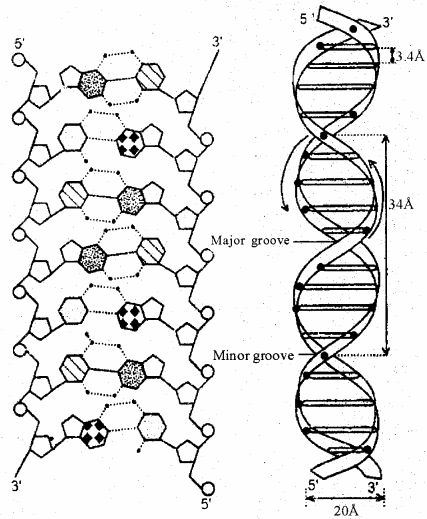
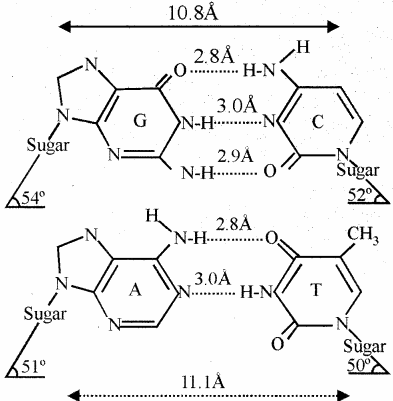
- DNA consists of two polynucleotide chains which are complementary to each other.
- Both the chain twist spirally and form a double helix.
- Both the chains are antiparallel i.e. they show polarity ie. the 5’→ 3’ direction of one strand runs opposite to the 3’→ 5’ direction of toher strand.
- DNA molecule exhibits right handed coiling (helical sense).
- The length of one coil is 34A° which includes 10 pairs of nucleotides. Hence, each nucleotide pair has a distance of 3.4A°.
- In DNA molecule, phosphates remain outside and the nitrogen bases remain in the centre.
- Both the chains remain held together with the help of hydrogen bonds formed between the nitrogen bases.
- There is specific pairing between the nitrogen bases. Adenine combines with thymine by two hydrogen bonds (A = T or T = A) and cytosine combines with guanine by three hydrogen bonds (C s G or G=C).
- According to ChargafFs rue, the base ratio is one. or A=T=C=G=1 Purine (A + G) = Pyrimidines (C + T)
- The common nuclear DNA is also called as B-DNA.
- The angle of nucleotides from the axis (base tilt normal to the helix axis) is 6°.
Question 3.
Give an account of replication of DNA.
Answer:
DNA Replication:
The formation of DNA molecule using DNA templet is called as replication. In this process one DNA molecule forms two similar copies of DNA The process of replication normally takes place in the nucleus but in prokaryotes, it occurs in the cytoplasm.
Replication is the basis of continuity of life. It takes place only during S-phase of interphase (cell cycle). Korenberg described complete process of replication, which is as follows-
(i) Replication takes place by semiconservative method which was given by Watson & Crick (1953). It was proved & supported by M. Meselson and F. Stahl (1958) with the help of radio isotope technique. They used N14 & N15 isotopes. According to it, both the polynucleotide chains are separated and simutaneously new complementary chains are formed along the old chains.
(ii) The process of replication begins at specific points called starting or initiating points. There may be one, two or more such points.
(iii) To begin the process of replication, a piece of RNA is required which is termed as RNA primer. The RNA primers in eukaryotes are short having 50 to 100 nucleotides. In prokaryotes, the RNA primar are longer and have 100 to 200 nucleotides.
(iv) Replication always takes place from 5 ’ end to 3′ end (5’→3′ end) i.e. formation of new chain beings at 5 ’end.
(v) The process of replication is discontinuous i.e. it takes place in small chains (pieces) which are called as Okazaki fragments (Okazaki & Coworkers, 1968). The Okazaki fragments are smaller in eukaryotes containing 100-150 nucleotides. In prokaryotes, the Okazaki fragments are longer having 1000 to 2000 nucleotides.
(vi) The process of replication is unidirectiona or bidirectional. Normally, it is bidirectional.
(vii) The process of replication involves about 20 enzymes which are collectively called as replisome or replicase system.
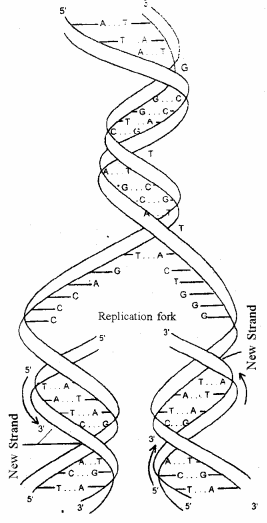
Some of the main enzymes are as follows-
(i) DNA helicase – It separates the two strands of the DNA molecule. It binds at the replication fork. It is also called as unwinding enzyme.
(ii) Restriction endonuclease – It cuts the DNA molecule at or near specific recognition nucleotide sequences known as restriction sites. It is also called as molecule scissors or DNA knife or molecular scalpel.
(iii) DNA polymerase I and III – They help in the formation of polynucleotide chain. Polymerase-I was discovered by Arthur Korenberg (1955) and polymerase-III was discovered by Thomas Korenberg (son of Aurther Korenberg) and Gefter (1970). Polymerase-III also separates RNA primer from the DNA after replication.
(iv) DNA Ligase – It joins the Okazaki fragment to form complete chain. In circular DNA, it links the two ends of the DNA chain.
(v) DNA gyrase – It increases twisting in DNA molecule & form compact structure.
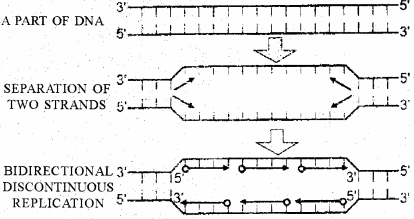
In addition DBP (DNA Binding Proteins) which interact with major groove of B-DNA. They have DNA domains like
zinc finger, leucine zipper etc.
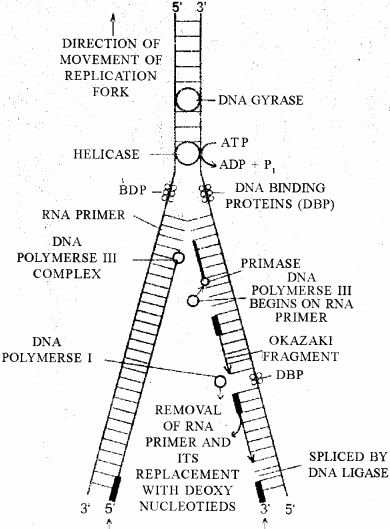
Question 4.
Write the structure and chemical composition of RNA.
Answer:
Chemical composition: It consists of following chemical substances-
- Phosphric acid : It’s phosphate group unites to 5’ carbon of one and 3’ carbon of second sugar and from phosphodiester bond.
- Sugar : It is a pentose sugar which is ribose type. It has one -OH group at carbon number 2.
- Nitrogen bases : It has four types of nitrogen bases viz. – adenine (A) and Guanine (G) as purines and Cytosine (C) and Uracil (U), as pyrimidines : Thymine of DNA is replaced by Uracil. In uracil pyrimidine one methyl group is less.
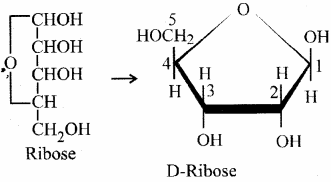
- RNA consists of one polynucleotide chain (single stranded) which consists of four types of nucleotids viz.-
(a) P + S + A – Riboadenylic acid (AMP)
(b) P + S + G – Riboguanylic acid (GMP)
(c) P + S + C – Ribocytidylic acid (CMP)
(d) P + S + U – Ribouradylic acid (UMP)
Structure of RNA:
It consists of one polynucleotide chain which bends in the middle twists on it self to form single helix. A molecule of RNA consists of both helical (coiled) and non-helical (uncoiled) parts. RNA can be single stranded (SS) or double stranded (dS). In RNA, the base ratio is never one i.e

Question 5.
Describe various types of RNA.
Answer:
types of RNA
RNA is of two types viz. –
(A) Genetic RNA:
The RNA viruses eg plant virus, some animal virus, some bacteriophages etc. are without DNA, hence RNA acts as hereditory material.
Examples :
- Plant viruses : Rice dwarf virus (dS RNA).
- Animal viruses : Rheo virus (dS RNA), wound tumour virus (dS RNA), Influenza virus (SS RNA), Polio virus (SS RNA).
- Bacteriophages – MS2 (SS RNA), S-17 coliphage (SS RNA).
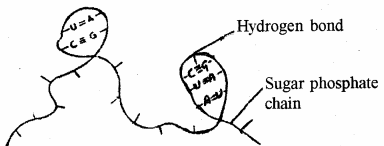
(B) Non-genetic RNA
It is found in those organisms where DNA acts as hereditory material. In these organism, RNA primarily participate in protein synthesis. The non – genetical RNA is of three types-
(i) Messenger RNA (mRNA) – it is a large family of RNA molecules. It brings information of protein synthesis from DNA to the cytoplasm. In mRNA, this information is coded in the form of sequence of nucleotides (genetic code).
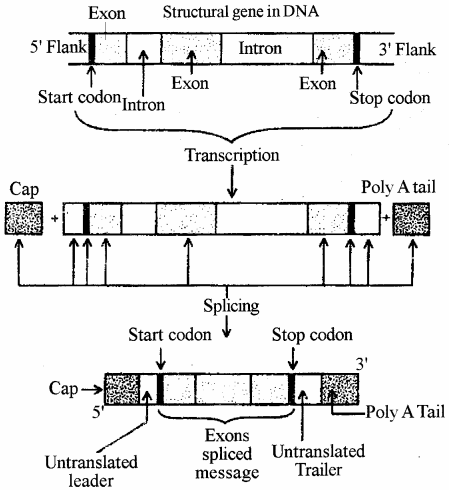
(ii) Ribosonial RNA (rRNA) – It is found in the ribosomes. It is the maximum among all the three RNA (about 80% of total RNA) and it is of 6 types. It is a stable RNA i.e. it’s life span is more. It reads the message coded in the mRNA at the time of protein synthesis, catalyze the assembly of amino acids into protein chains and they also bind t RNAs.
(iii) Transfer RNA (tRNA) – It is also called as soluble RNA (sRNA). It is found freely in the cytoplasm. They are of 60 types. They are small and have 75 to 80 nucleotides. The structure of tRNA can be explained with the help of Clover leaf model which was propounded by Robert Holley (1965). For this discovry, Holley was awarded Nobel prize of 1968 along with Khorana & Nirenbery.
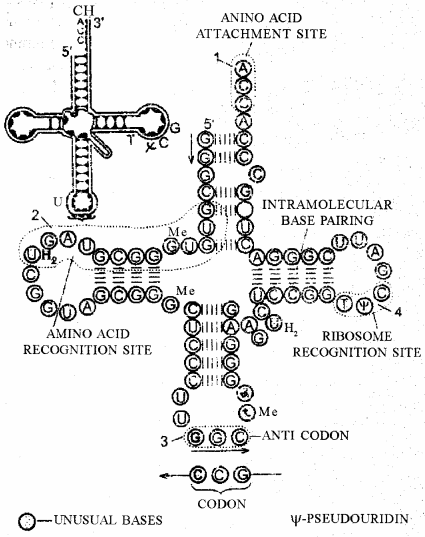
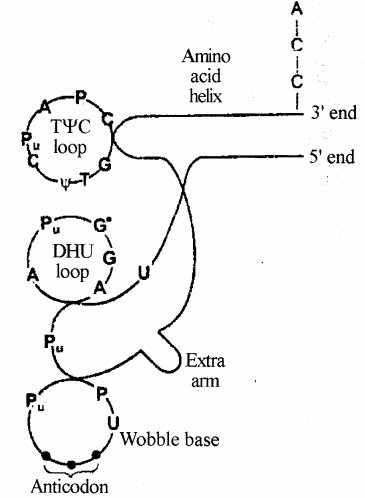
Transfer RNA plays important role during protein synthesis. They activate the amino acids, bring these amino acids at the site of protein synthesis and transfer the amino acids at the required position as guided by the mRNA. They were also named as adaptor RNA (aRNA) by Crick.
Question 6.
Write an essay on genetic code.
Answer:
Messenger RNA encodes a genetic message for protein synthesis which is decided by the DNA, as mRNA is transcribed by the DNA. The genetic message in mRNA is in the form of a sequence of nucleotides (bases). A specific sequence of nucleotides in mRNA specify one amino acid which is called as codon. The base sequence in tRNA that combines with codon is called as anticodon. The sequence of the nucleotides (bases) in mRNA that code 20 amino acids is called as genetic code. There are four types of nucleotides (bases) in mRNA and their arrangement code 20 amino acids.
Initially, singlet codon concept was considered which means one base (mucleotide) codes one amino acid. It gives only 4 genetic codes [4 x 1⇒ 4] which are very less to code 20 amino acids, hence discarded. Lateron, doublet codon concept was considered in which two nucleotides code one amino acid. This gives 16 genetic codes [4 x 4 ⇒ 16] which are not sufficient to code 20 amino acids, hence discarded.
Triplet Genetic Code:
Crick, Brenner et al. first demostrated that codons consist of three bases. Marshall Nirenberg and Heinrich J. Mathaei (1961) where the first to reveal the nature of a codon. According to triplet codon concept, three nucleotides (base) code one amino acid. It gives 64 genetic codes [4 x 4 x 4 = 64] which are more than enough to code 20 amino acids.
Holley, Khorana & Nirenberg studied all the 64 genetic codes, for this work they were awarded Nobel prize of 1968 in medicine/physiology. Nirenberg worked with Leder & determined 54 codons but Leder was not given the Noble prize

Salient Features of Triplet Genetic Code:
1.The genetic code is collinear i.e. all the nucleotides (genetic codes) in mRNA are arranged in one line (It is called as colinearity).
2. The genetic code is universal i.e. it is common for all organisms and even in viruses also. However, genetic code of mammalian mitochondria is slightly different.
3. The genetic code is non-overlapping i.e. after three nucleotides, the next three nucleotides form a new or next genetic code.
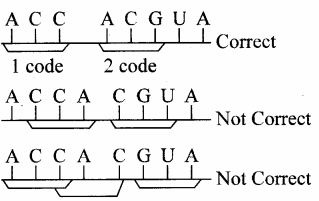
4. The genetic code is non-ambiguous i.e. one genetic code express only one amino acid.
5. The genetic code is commaless i.e. there is no code which denotes comma (,). The successive codons are contiguous and not separated by non coding bases or group of bases.
6. The genetic code always begins with AUG, hence AUG is called as starting codon or Initiating codon. The AUG code stands for metheonine is eukaryotes and for formyl methionine is prokaryotes. The mitochondrial genetic code in human beings use alternate start codons viz. – AUA and AUU and in some prokaryotes the alternate start condons are GUG&UUG .
7. The standard genetic code has three stop codons viz. – UAA (Ochre), UAG (Amber) and UGA (Opal). The protein synthesis stops when any one comes in the sequence. Hence, they are also called as terminating codons. They do not code (express) any amino acid, hence they are also called as non-sense codons. No tRNAs exist for these codons.
8. The genetic code exhibits degeneracy, as it has many codons which have same meaning i.e. different codons specify the same amino acid. Hence, the common genetic code is a degenerate code. Eighteen amino acids out of 20 are expressed by more than one genetic codes.
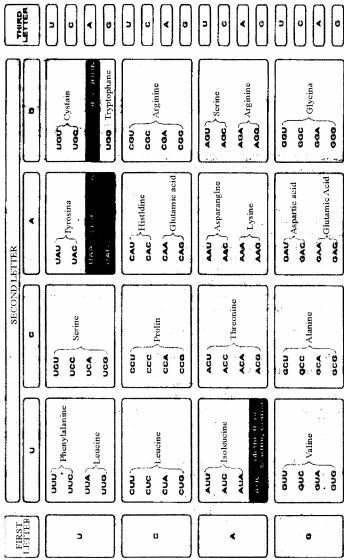
Question 7.
Explain translation in protein synthesis.
Answer:
Process of Translation
The process in which sequence of nucleotides in mRNA is translated into the sequence of amino acids of a polypeptide chain is called as translation. It involves three steps viz- initiation, elongation & termination.
(A) Initiation
Initiation of polypeptide chain begins with the codon AUG The codon AUG stands for methionine, hence, the formation of polypeptide begins with methionine amino acid.
- Initiation of polypeptide chain in prokaryotes : In prokaryotes, the initiation is brought about by formylated methionine. The small subunit of ribosome (30S) combines to the 5′ end of mRNA with codon (AUG). There is formation of complex by 30S ribosome, mRNA, formyl methionine & tRNAf. met i.e. (30S mRNA) f.met-tRNAf met. Now, the large subunit (50S) combines to form 70S
ribosome & the translation begins. Initiation factors, IF 1,IF2&IF3 and GTP promote the initiation process. - Initiation of polypeptide chain in eukaryotes : Eukaryotes per-form the initiation step by a mechanism similar to that used by prokaryotes, but ordinary methionine amino acid, instead of formyl methionine, plays the initiation role. The ordinary’ methionine bound to tRNA met.
(B) Elongation:
The elongation of the polypeptide chain begins after the formation of 70S mRNA f.met-tRNAfmet complex. The ribosomes translate an mRNA in the 5′ → 3′ direction. Hence, the protein or polypeptide grows in the amino (N) to carboxyl
- direction – i.e. N – terminal amino acid is added first, and the C-terminal amino acid is added last.
There are two binding sites on the larger subunit of ribosome for aminoacyl- tRNA viz – P- site (Peptidyl) & A – site (aminoacyl). The tRNAfinet is in the P- site. The second codon in mRNA is in the A – site, hence the second aminoacyl – tRNA will bindto this site. This binding requires a protein elongation factor (EF – Tp) & GTP.
Next, the first peptide bond is formed, an enzyme peptidyl transferase (found in the larger subunit) transfer the f. methionine from its tRNAfinet in the P- site to the aminoacyl – tRNA in the A – site. This assembly is called as dipeptidyl – tRNA. The tRNA at P- site is said to be decylated. In the next step, the deacylated tRNA in the P- site leaves the ribosome. The dipeptidyl – tRNA in the A-site moves into the P- site of the larger sub – unit. This process is called as translocation and it requires GTP & c factor called EF- G. No the ribosome shifts along mRNA in 5′ ® 3′ direction, so that the next codon on mRNA is available at A- site. The process then repeats to add another amino acid.
As one ribosome moves along the length of mRNA, the initiation point on mRNA becomes free which can form initiation complex with another ribosome. In this way, 3 to 5 ribosomes get attached to a single mRNA molecule, each with a polypeptide chain under formation.
(C) Termination:
There are three terminating codons in the genetic code viz- UAA, UAG & UGA which do not code for amino acid, hence are also called as nonsense codons. Termination of polypeptide chain occurs when the ribosome carrying polypeptidyl- tRNA reaches any one of the terminating codon. However, releasing factors RF1, RF2 & RF3 are required for chain termination in prokaryotes. In eukaryotes, single releasing factor, eRF, causes termination. The free ribosome also dissociates into two subunit with the help of dissociation factor. It is observed that if any one of the terminating codon occurs in the middle of the message, premature termination takes place.
Modification of released polypetide:
The just release polypeptide is linear and has primary structure. The formyl group from the first amino acid is removed by an enzyme deformylase. It may lose some amino acids either from N-terminal or C-terminal or from both terminals with the help of exopentidase enzyme. The reamining polypeptide may gets coiled or folded to from secondary or tertiary structure.
